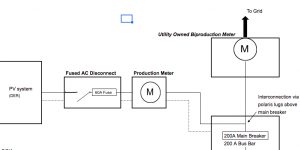RickwithSisuSolar
Member
- Location
- Minnesota
- Occupation
- Solar Installer
Hi I am in the midst of applying for Utility incentives for a solar install. I am planning on connecting a 11.5kW DC system with a line tap just above the home's main breaker. Further down this line will be a production meter and utility AC disconnect (fused). The utility says that there must be a OCPD (fuse, MCB, or fused disconnect, immediately after the interconnection. They also say that the utility AC disconnect must be in between the PV system and the production meter. I'm a bit confused because I thought that a single fused AC disconnect would suffice for the line tap's OCPD, even if there is a production meter between the OCPD and the line tap. Below is a picture of my original plan and the utility's words.

UTILITY'S WORDS:
3.7 - Note - Protective device shall be provided immediately after the main service meter. There must be protection in the form of a breaker or fuse or fused AC disconnect between the DER and utility located immediately after the main service meter.
3.21.2 - For installations that require a Production Meter, the Utility AC Disconnect shall be located between the DER and production meter. Ensure this is satisfied when addressing 3.18. In this design, a single device cannot simultaneously satisfy 3.7 and 3.21.2. There needs to a be a Utility AC Disconnect in appropriate location AND a protective device in appropriate location. Note that if there are two or more AC disconnects, only one should be distinguished as Utility.
I have a gut feeling that I'm missing something. But maybe not.
Whats the most effective way to put an OCPD between the production meter and the line tap? A second AC fused disconnect? (changing the first to a non-fused one)

UTILITY'S WORDS:
3.7 - Note - Protective device shall be provided immediately after the main service meter. There must be protection in the form of a breaker or fuse or fused AC disconnect between the DER and utility located immediately after the main service meter.
3.21.2 - For installations that require a Production Meter, the Utility AC Disconnect shall be located between the DER and production meter. Ensure this is satisfied when addressing 3.18. In this design, a single device cannot simultaneously satisfy 3.7 and 3.21.2. There needs to a be a Utility AC Disconnect in appropriate location AND a protective device in appropriate location. Note that if there are two or more AC disconnects, only one should be distinguished as Utility.
I have a gut feeling that I'm missing something. But maybe not.
Whats the most effective way to put an OCPD between the production meter and the line tap? A second AC fused disconnect? (changing the first to a non-fused one)

